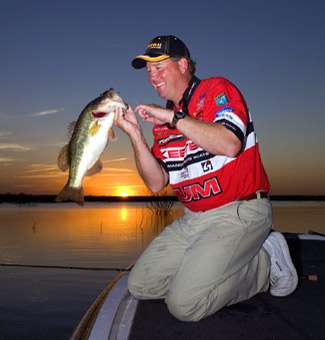
Not many bass fishermen relish the idea of crawling a jig through thick timber in 40 feet of water for only five strikes a day, but that's exactly how Alton Jones won the 2008 Bassmaster Classic. He used 14-pound fluorocarbon for the job, but if he'd spooled on 17-pound, he probably wouldn't have won.
"The slightly heavier line cut the number of strikes I was getting by 20 percent," explained Jones, who had used it the previous day. "When you're only getting five strikes a day, that means I would have had only four fish, not five, on the final day of the Classic, and it was the fifth bass that won for me."
Choosing a line by its strength, as anglers used to do, is not the only choice today's bass fishermen must make, and sometimes line strength isn't even the primary consideration anymore. A more basic problem is simply choosing the type of line to use.
Fluorocarbon, braid and monofilament each have certain characteristics making one more suitable for certain techniques or conditions than the others. Never before have anglers faced so many choices with fishing lines.
Fluorocarbon, for example, has low visibility, low stretch, high strength, and it sinks, but some brands are stiffer than monofilament and more difficult to cast.
Braided lines, by comparison, have extreme strength and abrasion resistance but no stretch, and because they do float their high visibility can make them a poor choice in clear water. Monofilaments are just the opposite, with low visibility and high stretch, and they also float.
While each fisherman will need to evaluate his own fishing style and techniques, studying the line choices of a champion like Jones can help anyone improve his strike and catch ratio. Here's what he picks:
Spinnerbaits: "I use 17-pound fluorocarbon because it has lower visibility and enough strength to bring bass out of shallow cover," says Jones, "and because it has less stretch than monofilament, I get a more secure hook set. The less stretch a line has the better feel you have for the lure itself, which is crucial with spinnerbaits."
Crankbaits and Jerkbaits: "In water less than 8 feet, I use 14 or 17-pound fluorocarbon for crankbaits, depending on the cover and size of fish, while in deeper water I prefer 12-pound fluorocarbon. For jerkbaits, I'll use 10- or 12-pound fluorocarbon."Fluorocarbon has a thinner diameter than monofilament, so you can use slightly heavier lines and still achieve the depth you need, and in clear water it's nearly invisible. I don't use braid because I need some stretch to keep the line tight when a fish hits."
Flipping and Pitching: "I prefer 50-pound braid most of the time, but I may drop to 30 or increase to 65, depending on the cover and size of the fish," continues Jones. "I'll also use a 25-pound fluorocarbon leader, primarily for lower visibility and for stealth. Braided line makes a lot of noise as it rubs against limbs and branches, and the leader helps silence my presentation. The fluorocarbon also acts as a type of shock leader, too, because the braid has no stretch. With a hard hook set, you can rip a hook out of a fish's mouth."
Topwaters: "This is practically the only time I use monofilament line anymore, and most often it will be 12-pound test. I want some stretch, and, because it floats, I get better lure action. The exception I make is with floating frogs, when I use 50-pound braided line. With a frog, I'm making long casts into cover, and the larger hooks make hook setting harder, so I don't want any stretch."
Texas and Carolina Rigs: "For these I prefer 50-pound braid with a fluorocarbon leader, although in very clear water I'll use 30-pound braid with a 20-pound fluorocarbon leader. These are bottom crawling presentations, usually around cover and with longer casts, so I want line strength without stretch."
Shaky Heads and Drop Shots: "Because I normally use these presentations in deep, clear water with spinning rods, I prefer 6-, 8- and 10-pound fluorocarbon," Jones points out. "I don't use braid because of its high visibility."
Swimbaits: "With the smaller hollow-body lures, I use 50-pound braid with a 25-pound fluorocarbon leader in heavy cover for big bass, but in open water I prefer 17- and 20-pound fluorocarbon, although I'll usually modify the lure by adding a treble hook to make hook sets easier.
"When I'm fishing the larger 'California-style' swimbaits, I'll use 20-pound fluorocarbon. I normally do not fish these lures in heavy cover, so that size fluorocarbon is strong enough to handle a big fish."
The Classic champ emphasizes these are line choices that fit his personal style of fishing, and in fact, he uses several different brands of fluorocarbon for different techniques because of their varying degrees of stiffness.
"The best way to make a line choice is simply to try different types and weights of lines for each presentation and see which one best suits the way you fish," the Texas pro concludes. "It will take some time, but in the end, I can guarantee your fishing will improve."




